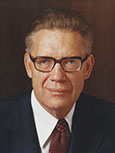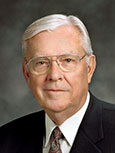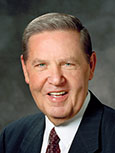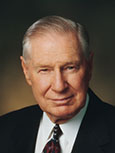Introduction
Before the Savior suffered in Gethsemane, He offered His great Intercessory Prayer. He prayed that His disciples and all who follow Him would come to know Heavenly Father and obtain eternal life, and He prayed that they might be one with Him and His Father.
Suggestions for Teaching
John 17:1–8
Jesus Christ addresses Heavenly Father in prayer
Invite students to name famous people whom they know something about. Then ask them to name the people in their lives whom they know the best.
- • What is the difference between knowing aboutsomeone and actually knowing that person?
- • What does it take to really know someone?
- • Who are some individuals whom you feel would be important for you to get to know better? Why?
Explain that the Savior taught about the importance of coming to know Heavenly Father and Him. Invite students to look for truths as they study John 17 that will help them come to know Heavenly Father and Jesus Christ.
To help students understand the context of John 17, point out that at some point between the time when the Savior and His disciples had eaten the Last Supper and when they entered the Garden of Gethsemane, Jesus offered a prayer that is traditionally known as the Intercessory Prayer. One meaning of the word intercedeis to speak to someone in behalf of another person. In this case, Jesus Christ spoke to Heavenly Father in behalf of His disciples, pleading that they might receive eternal life.
Invite a student to read John 17:1–3 aloud. Ask the class to follow along, looking for how the Savior described eternal life.
- • How did the Savior describe eternal life?
- • Based on verse 3, how would you state a principle that teaches what we must do to receive eternal life? (Students may use different words, but make sure it is clear that to receive eternal life, we must come to know Heavenly Father and His Son, Jesus Christ.)
To help the class understand what it means to know God, invite a student to read aloud the following statement by Elder Bruce R. McConkie of the Quorum of the Twelve Apostles:

“It is one thing to know about God and another to know him. We know about him when we learn that he is a personal being in whose image man is created; when we learn that the Son is in the express image of his Father’s person; when we learn that both the Father and the Son possess certain specified attributes and powers. But we know them, in the sense of gaining eternal life, when we enjoy and experience the same things they do. To know God is to think what he thinks, to feel what he feels, to have the power he possesses, to comprehend the truths he understands, and to do what he does. Those who know God become like him, and have his kind of life, which is eternal life” (Doctrinal New Testament Commentary, 3 vols. [1965–73], 1:762).
- • How is knowing the Father and the Son different from simply knowing about Them?
- • Why can’t a person obtain eternal life without knowing God the Father and Jesus Christ?
- • What are some ways we can come to know the Father and the Son?
Summarize John 17:4–5 by explaining that the Savior reported to His Father that He had finished the work His Father had given Him to do. He asked His Father to glorify Him with the same glory He had had in the premortal life.
Invite a student to read John 17:6–8 aloud. Ask the class to follow along, looking for what His disciples had done to come to know the Savior.
- • What had the disciples done to come to know the Savior? (You may want to encourage students to mark the phrases “received them,” “known surely,” and “believed” in verse 8.)
John 17:9–19
The Savior prays for His disciples
Invite a student to read John 17:9 aloud. Ask the class to follow along, looking for whom the Savior specifically prayed for.
- • Whom did the Savior pray for as He was about to begin carrying out the Atonement?
- • Why do you think the Apostles may have benefited from hearing the Savior plead in their behalf?
Write John 17:11–18 on the board. Divide students into pairs. Invite them to study these verses with their partners, looking for what Jesus pled for in behalf of His disciples. You may want to invite students to mark what they find. After sufficient time, ask several to report what they found to the class.
Point out that the Savior mentioned that His disciples would continue living in a world that was evil and that hated them.
- • What truth can we learn from verses 14–16 about living in the world as disciples of Jesus Christ? (After students respond, write the following truth on the board: As disciples of Jesus Christ, we are to be in the world but not of the world.)
- • What do you think it means to be in the world but not of the world?
Invite a student to read aloud the following statement by Elder M. Russell Ballard of the Quorum of the Twelve Apostles:

“In the Church, we often state the couplet: ‘Be in the world but not of the world.’ …
“Perhaps we should state the couplet … as two separate admonitions. First, ‘Be in the world.’ Be involved; be informed. Try to be understanding and tolerant and to appreciate diversity. Make meaningful contributions to society through service and involvement. Second, ‘Be not of the world.’ Do not follow wrong paths or bend to accommodate or accept what is not right. …
“Members of the Church need to influence more than we are influenced. We should work to stem the tide of sin and evil instead of passively being swept along by it. We each need to help solve the problem rather than avoid or ignore it” (“The Effects of Television,” Ensign, May 1989, 80).
- • Why does the Lord want us to remain in the world while not being of the world?
Invite students to work with their partners again and think of an example of how a person could be in the world but not of the world in each of the following settings:
- 1. At school
- 2. With friends
- 3. Online
After sufficient time, invite a few students to explain to the class the examples they thought of. Invite a few students to share experiences they have had when they, or someone they know, appropriately demonstrated being in the world but not of the world.
Invite students to write in their class notebooks or scripture study journals one specific way they will seek to better follow the Savior by being in the world and not of the world.
John 17:20–26
The Savior prays for all people who accept His gospel
Invite a student to come to the front of the class and perform a task that will get his or her hands dirty (such as cleaning off the erasers from the board or digging for an item in a bowl of dirt). Encourage the student to try to keep his or her hands clean while performing the task.
After the student completes the task, ask the student to display his or her hands to the class.
- • How might this activity be like our efforts to be in the world but not of the world? (Despite our best efforts, we do not remain completely clean from the sins and evil that exist in the world.)
- • If we could not be cleansed from our sins, what consequences would we ultimately experience? Why? (We would be separated from the presence of God forever because no unclean thing can dwell in His presence [see 1 Nephi 15:33–34].)
Thank the student, and ask him or her to be seated.
Invite a student to read John 17:20–23 aloud. Ask the class to follow along, looking for what Jesus Christ prayed for.
- • What did Jesus Christ pray for? (You may want to suggest that students mark the word one wherever it appears in verses 20–23.)
- • What makes it possible for us to become one with the Father and the Son? (The blessings of the Atonement of Jesus Christ, which we receive by obeying His commandments, and the gift of the Holy Ghost.)
Write the following truth on the board: As we come unto Jesus Christ and receive the blessings of His Atonement, we can become one with the Father and the Son.
Invite a student to read aloud the following statement by Elder Jeffrey R. Holland of the Quorum of the Twelve Apostles:

“The literal meaning of the English word Atonement is self-evident: at-one-ment, the bringing together of things that have been separated or estranged” (“The Atonement of Jesus Christ,” Ensign, Mar. 2008, 34–35).
- • From what you know of Heavenly Father and Jesus Christ, why do you want to become one with Them?
Invite a student to read aloud the following statement by President James E. Faust of the First Presidency. Ask the class to listen for the blessing that will come to those who seek to be one with Heavenly Father and Jesus Christ.

“We should earnestly seek not just to know about the Master, but to strive, as He invited, to be one with Him (see John 17:21). …
“… The days ahead will be filled with affliction and difficulty. But with the assuring comfort of a personal relationship with God, we will be given a calming courage” (“That We Might Know Thee,” Ensign, Jan. 1999, 2, 5).
Testify of the importance of coming to know Jesus Christ and Heavenly Father and of seeking to be one with Them.
Invite students to ponder what they can do to better know Heavenly Father and Jesus Christ and strengthen their relationship with Them.
Invite students to record their thoughts in their scripture study journals or class notebooks. After sufficient time, invite a few students who are willing to share their thoughts and feelings with the class.
 Scripture Mastery—John 17:3
Scripture Mastery—John 17:3
To help students memorize John 17:3, invite them to carry the scripture mastery card containing this passage with them during the next week. Encourage them to review the passage and practice saying it as opportunities arise. You may want to suggest that they try to recite it from memory to a family member and explain its meaning. At the beginning of class for the next few days, invite students to report on their progress with memorizing this passage.
Commentary and Background Information
John 17:3. To know God the Father and Jesus Christ
To know the Father and the Son we must have a correct understanding of Them. Many people believe that God and the Godhead are incomprehensible, but this is a false doctrine.
Elder Bruce R. McConkie of the Quorum of the Twelve Apostles explained:
“The greatest truth known to man is that there is a God in heaven who is infinite and eternal; that he is the creator, upholder, and preserver of all things; that he created us and the sidereal heavens and ordained and established a plan of salvation whereby we might advance and progress and become like him. The truth pertaining to him is that he is our Father in heaven, that he has a body of flesh and bones as tangible as man’s, that he is a literal person, and that if we believe and obey his laws we can gain the exaltation which he possesses. Now that is the greatest truth and the most glorious concept known to the human mind” (“The Seven Deadly Heresies” [Brigham Young University fireside, June 1, 1980], 7, speeches.byu.edu).
John 17:12. “The son of perdition”
It appears that Jesus Christ used the words “son of perdition” to refer to Judas Iscariot, who at this point had left Jesus and the other eleven Apostles in order to betray Jesus to the corrupt Jewish leaders. Elder Bruce R. McConkie of the Quorum of the Twelve Apostles noted, “Judas … was probably not a son of perdition in the sense of one who is damned forever, but in the sense that he was a son or follower of Satan in this life. See Matt. 26:21–25” (Doctrinal New Testament Commentary, 3 vols. [1965–73], 1:765).
John 17:20–23. “Them … which shall believe on me through their word”
Although Jesus Christ began His Intercessory Prayer by praying for the disciples who were with Him, He expanded His prayer to include all who believe on Him “through their word.” Members of the Lord’s Church will come to know Jesus Christ through the witness and teachings of the Apostles. This helps us understand the importance of studying the teachings of the First Presidency and the Quorum of Twelve Apostles today. The word them in verse 22 refers to the Apostles and faithful members who have studied their teachings and are in harmony with them as they are with the Son of God. For more information concerning how we “may be made perfect in one” (John 17:23), see Doctrine and Covenants 76:69.
Supplemental Teaching Idea
John 17:20–22. “That they may be one, even as we are one”
Explain that in order for us to become one with the Father and the Son as They are one, we must have a correct understanding of the nature of the Godhead. Copy the following chart on the board, and invite students to copy it into their class notebooks or scripture study journals. (If you prefer, you can provide students with copies.) Give students time to match each scripture reference in the chart with the correct explanation from John 17 of how the Father and the Son are one.
HOW THE FATHER AND THE SON ARE ONE
| |
|---|---|
|
|
After sufficient time, invite students to share their answers. (Answers: 1-e; 2-d; 3-b; 4-a; 5-c.) Then write the following truth on the board: The Father and the Son are one in glory, power, truth, purpose, and love.
Invite a student to read aloud the following statement by Elder Jeffrey R. Holland of the Quorum of the Twelve Apostles, in which he described the unity that exists among Heavenly Father, Jesus Christ, and the Holy Ghost:
“We believe these three divine persons constituting a single Godhead are united in purpose, in manner, in testimony, in mission. We believe Them to be filled with the same godly sense of mercy and love, justice and grace, patience, forgiveness, and redemption. I think it is accurate to say we believe They are one in every significant and eternal aspect imaginable exceptbelieving Them to be three persons combined in one substance, a Trinitarian notion never set forth in the scriptures because it is not true” (“The Only True God and Jesus Christ Whom He Hath Sent,” Ensign or Liahona, Nov. 2007, 40).
沒有留言:
張貼留言